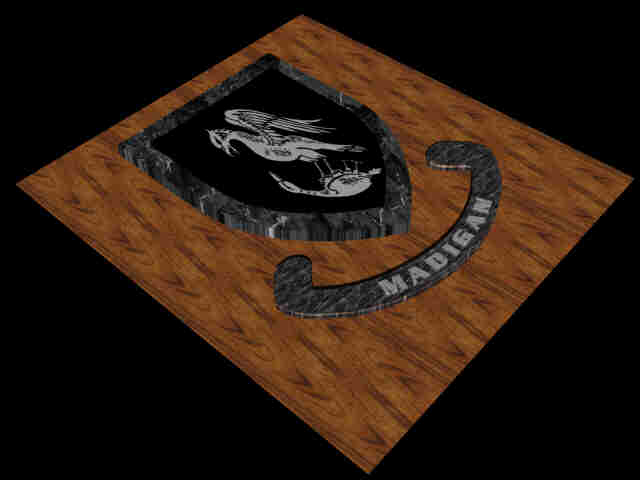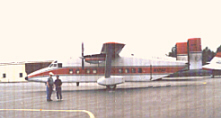 We then proceeded to the ready room
which contains the lockers of the various jumpers.
When a fire call comes in, the center uses a klaxon
to summon those on the jump list, for the next
jump. This is followed by the public address
calling of the name of each of the 16 jumpers
scheduled for this launch. When dressed, the
jumpers fling open the large aluminum overhead
door and charge out and board either the British
built “Short Serpa”, or the “DC-3” (C-47 for old
WWII paratroopers) airplanes, which are standing
by. (The pilots having boarded and started the
plane prior to their arrival).
We then proceeded to the ready room
which contains the lockers of the various jumpers.
When a fire call comes in, the center uses a klaxon
to summon those on the jump list, for the next
jump. This is followed by the public address
calling of the name of each of the 16 jumpers
scheduled for this launch. When dressed, the
jumpers fling open the large aluminum overhead
door and charge out and board either the British
built “Short Serpa”, or the “DC-3” (C-47 for old
WWII paratroopers) airplanes, which are standing
by. (The pilots having boarded and started the
plane prior to their arrival).
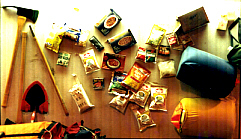 Not far from the launch bay, are two displays,
depicting what might be dropped with them. Most
food carries the nickname of it’s military
counterpart MRE for meals ready to eat. The idea
is, only hot water is required to make a meal, but
it’s edible cold. The tools are, for the most part,
non-power hand tools like an ax, pick and shovel.
There is a specially designed first aid kit, which
covers far greater medical emergencies,
Not far from the launch bay, are two displays,
depicting what might be dropped with them. Most
food carries the nickname of it’s military
counterpart MRE for meals ready to eat. The idea
is, only hot water is required to make a meal, but
it’s edible cold. The tools are, for the most part,
non-power hand tools like an ax, pick and shovel.
There is a specially designed first aid kit, which
covers far greater medical emergencies,
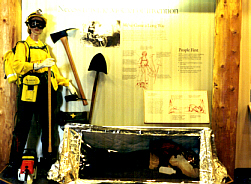 included,
as is a “fire tent”. This is an invention of smoke
jumper research. It is a somewhat flimsy
aluminum foil, low-line tent that may be the only
thing that stands between retreating fire fighters
and the fires that outrun them. It is standard
equipment on every jump. This safety device was
not available to the 15 smoke jumpers who, in
1494, jumped into Mann Gulch north of Helena,
Montana, to bring under control, a 60 acre fire.
Searing winds unexpectedly fanned the fire across
3000 acres, killing 12 of the
included,
as is a “fire tent”. This is an invention of smoke
jumper research. It is a somewhat flimsy
aluminum foil, low-line tent that may be the only
thing that stands between retreating fire fighters
and the fires that outrun them. It is standard
equipment on every jump. This safety device was
not available to the 15 smoke jumpers who, in
1494, jumped into Mann Gulch north of Helena,
Montana, to bring under control, a 60 acre fire.
Searing winds unexpectedly fanned the fire across
3000 acres, killing 12 of the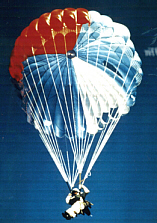 firefighters. A
memorial, outside the visitors center, stands as
tribute to their sacrifice. This job is seasonal, paying a little more then $10
an hr for standby time, for the barracked jumpers,
between May and September. Once in the field,
the pay goes up, with overtime and hazard
differentials. Applicants must be at least 18 years
old. Although parachute jumping experience is not
required, several years with the ground forest
fighting force is, before qualifying for the Smoke
Jumpers. There is also a rigorous annual physical
examination with a zero tolerance. Come
September, the center closes for the season, and
the jumpers are free to peruse other occupations.
Come next May, the men and women of this very
elite unit will be back, ready to qualify once again
for the research, training, and challenge of this
most unusual part-time employment.
firefighters. A
memorial, outside the visitors center, stands as
tribute to their sacrifice. This job is seasonal, paying a little more then $10
an hr for standby time, for the barracked jumpers,
between May and September. Once in the field,
the pay goes up, with overtime and hazard
differentials. Applicants must be at least 18 years
old. Although parachute jumping experience is not
required, several years with the ground forest
fighting force is, before qualifying for the Smoke
Jumpers. There is also a rigorous annual physical
examination with a zero tolerance. Come
September, the center closes for the season, and
the jumpers are free to peruse other occupations.
Come next May, the men and women of this very
elite unit will be back, ready to qualify once again
for the research, training, and challenge of this
most unusual part-time employment.
*** THE END ***

